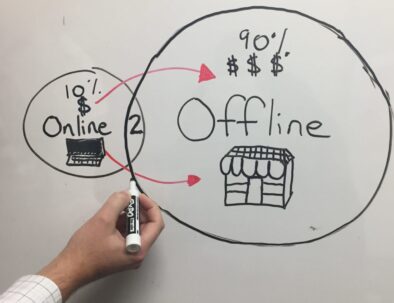In today’s connected and hectic World consumers want to simplify their lives. Many retailers have not adopted the technology required to cater to consumers making it more difficult to buy on their terms. This is creating immense pressure on manufacturers to offer consumers the conveniences and selection they desire. If channel partners are limiting sales obviously it is in the best interest of a manufacturer to ensure when there is demand for its products, consumers can obtain them.
Expanding Offline Retail into Online Channel Gives Consumers Ability to Buy on their Terms.
For the interest of satisfying end consumers and having closer relationships with them, many brands are looking towards online sales. The traditional direct to consumer approach limits manufacturers to roughly 10% reach of the market, whereas combining sales channels increases the transaction volume and consumer convenience to address 56% of shoppers.
Why is this important? Two thirds of consumers who frequently shop online say having a physical retail store near-by increases conversions both before and after purchase. Consumers want the convenience of online shopping combined with the pre and post purchase support the flexibility of buying offline provides (Read Article). An example includes being able to buy online and pickup at a store, or return locally if necessary. So a new form of eCommerce comes about which includes retailers into the online channel, otherwise known as omnichannel or clicks to bricks. Retailers can leverage their vendor’s online presence and consumers obtain the convenience only a local retailer can provide.
Building a Successful Partner Program
Creating a network of partners and resellers who are ready and eager to sell your product or service is not easy. Think about it, you’re essentially asking these people to buy your products, work on your behalf for free (until they sell something) to expand your brand in a cost-effective way to new regions and prospects. It takes work. But it is possible. And potentially lucrative.
So How Do You Do it?
It starts with identifying and recruiting the right partners to work with. The goal today is to focus on building targeted, mutually beneficial partnerships with similarly aligned partners:
- Make it a Win-Win Partnership: What will your partners get out of the relationship? What are their goals? Understand they, too, have a business they are trying to grow. So beyond increasing your bottom line, what will you provide them in return? How will you help them make money? Full collaboration is required including the sharing of customers and sales data to make everyone successful.
- Get Systems and Processes in Place.You must have a solid cohesive system between you and your dealers to share in the channel. These systems dictate procedures, automate workflows and ensure the program runs fluidly.
- Keep Partners Engaged: With content, collaboration, and customer success stories so they know the ecosystem is working and everyone in the channel is benefiting. This requires reporting metrics letting retailers know where they stand.
From its inception, digital has accelerated the opportunities for always-on interaction and sales channels, but it’s taken a while for the retail industry (via infrastructure and technology) and consumers (via behavior and devices) to reach full omnichannel potential. Although some brands have the basics right, leaders break away by employing omnichannel tactics and technologies across the entire retail operation to grow top line revenues by working with a dedicated technology solution provider.





